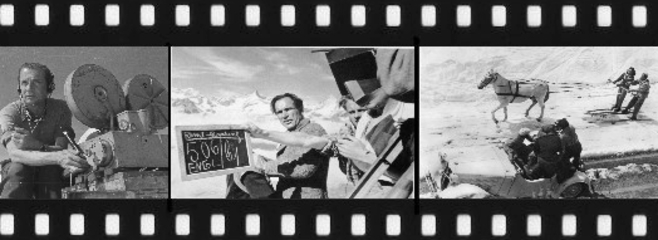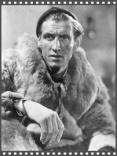
WaRis - Tiroler Filmarchiv
WALTER RIML
To the gallery
Walter Riml is born in Innsbruck on September 23th 1905.
His career begins in the mid 1920s. As a passionate skier he gets acquainted with pioneer of mountain filming Dr. Arnold Fanck in 1926. Dr. Fanck hires him as a skier for his silent film “The Great Leap”. While shooting Walter Riml meets Leni Riefenstahl and Luis Trenker, who are both of this early film by Arnold Fanck. Though at first Riml impresses Fanck with his skiing abilities Fanck soon after also discovers his talent as an actor and hires him for his next films as well. Along with Leni Riefenstahl, Hannes Schneider and Ernst Udet he appears in the films “Adventure in the Engadin” and “SOS Iceberg”. His part as a carpenter from Hamburg along with Guzzi Lantschner in the films “The White Ecstasy” and “Norpol – Ahoi!” are almost legendary. From this point on both are recognized as the German response to the Danish comedians Pat & Patachon.
But from the very beginning of his career Walter Riml is also interested in camera work and becomes an assistant to Hans Schneeberger and Richard Angst in 1927. Very soon he is part of the recognized group of cameramen of Dr. Arnold Fanck’s legendary “Freiburger Schule”, that gets famous for totally new recording technologies in ski- and mountain films.
In the early 1930s Walter Riml moves to Berlin. He constantly works as a cameraman until the outbreak of the Second World War. He shoots in Greenland, Japan, Italy, Germany, Austria and Switzerland. Leni Riefenstahl hires Walter Riml as the second cameraman and a still photographer for her film debut “The Blue Light” in 1932. The most famous photographs of Riefenstahl showing her as “Junta” for that very film were all taken by Walter Riml. Afterwards Leni Riefenstahl engaged him as one of all in all 19 cameramen for her film “Triumph of the Will” that depicts the Reich Party Congress. In 1935 Walter Riml once again travels to Greenland in order to shoot the film “The Great Ice – Alfred Wegeners Last Trip”. Whilst there he also shoots documentary material of glacier calving. In the mid 1930s he joins Arnold Fanck on a journey to Japan where he also works on the film “Die Tochter des Samurai” (1936) and several documentaries. One year later he is hired by Luis Trenker as a cameraman for his classic “The Mountain Calls.” After the outbreak of the Second World War Walter Riml is drafted as a war reporter. Many of his documents and film material are destroyed during a bombing raid on Berlin in 1944. This includes more than 30,000 negatives of his journeys to Japan and Greenland. Consequently projects that had been planned with American producer Paul Kohner cannot be realized. After the end of the war Walter Riml is engaged as a cameraman and special reporter by the American army. From autumn 1946 on he and director Eduard Wieser join to rebuild the Tyrolean Filmstudio (1946-1952) that up to this date remains unique in the region. In 1957 he is one of the first western cameramen to travel to the former Soviet Union. The documentary “Russia today” is produced there.
Until the early 1960s Walter Riml is responsible for the camera work in many popular mountain and country films. In 1962 his work is noticed by American director John Sturges who hires him as a second cameraman for the film “The Great Escape.”
In 1969 Peter Hunt requires his skills for several complicated shoots of the mountain and skiing scenes of the James Bond film “On Her Majesty’s Secret Service”.
His last film is shot for US television in 1970: A documentary about the film “The Last Valley” starring Michael Caine and Omar Sharif.
Walter Riml dies on June 21th 1994 from a severe case of cancer at the age of almost 89.
During his long life as a cameraman he shot more than 100 films and documentaries.
Walters homepage
Gallery of his estate


